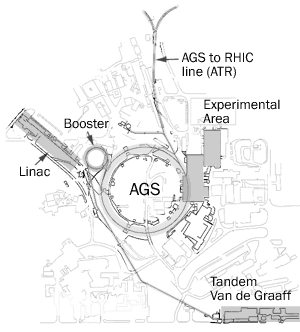Tandem Van de Graaff
Tandem Van de Graaff is a type of electrostatic accelerator.
MP Tandem Accelerators[]
There were ten MP Tandem Accelerators - six in North America, numbered 1-4 and 6-7,[1] and four in Europe, numbered 5 and 8-10.[2]
Yale MP-1 "Emperor" accelerator[]
The "MP-1" tandem accelerator at Yale University's Wright Nuclear Structure Laboratory (WSNL) was "the first of the MP machines to change from the conventional charging belt to the NEC-developed pelletron chain-charging system".[1] The MP-1 ceased operation in 2011, and WSNL was transformed into the new "Wright Lab," which opened in 2017.[3]
MP-2 at the University of Minnesota[]
This was the first MP accelerator to cease operations.[1]
MP-3 at Chalk River Laboratories in Canada[]
This accelerator "was the second such machine to be modified from a belt to a pelletron-charging system".[1]
MP-4 at the University of Rochester[]
"The sensitive method of monitoring conditioning by observing microdischarges in the acceleration tube sections with photomultiplier tubes looking at each section was also innovated by Rochester and is now used on other accelerators as well."[1]
MP-5 at Heidelberg[]
The three-stage facility at Brookhaven National Laboratory (MP-6 and MP-7)[]

The tandem accelerator facility at Brookhaven National Laboratory was the world's largest such facility when it was built in 1970.[4] It can provide researchers with beams of more than 40 different types of ions, from hydrogen to iron, that have been completely stripped of their electrons. It consists of two 15 million volt electrostatic accelerators, each about 24 meters long.[4]
Tandem Van de Graaff serves as the ion source for the Relativistic Heavy Ion Collider (RHIC).[4] Ions generated in the Tandem Van de Graaff travel through a 700-meter-long tunnel, the Tandem to Booster (TtB) Line, to the Alternating Gradient Booster. The Booster delivers the ions to the Alternating Gradient Synchrotron (AGS), which further accelerates them before they enter the RHIC.
MP-8 at Munich[]
MP-9 at Orsay[]
MP-10 at Strasbourg[]
References[]
- ^ a b c d e Wegner, H.E.; Thieberger, P. (1977). "North-American MP tandem accelerators". Revue de Physique Appliquée. 12 (10): 1291–1301. doi:10.1051/rphysap:0197700120100129100. ISSN 0035-1687.
- ^ Skorka, S.J. (1977). "The European MP-Tandems". Revue de Physique Appliquée. 12 (10): 1279–1290. doi:10.1051/rphysap:0197700120100127900. ISSN 0035-1687.
- ^ Misenti, Victoria (2018-02-14). "History". Wright Laboratory. Retrieved 2021-08-12.
- ^ a b c "Tandem Van de Graaff". Brookhaven National Laboratory. 2008. Archived from the original on 2010-02-19. Retrieved 2010-09-27.
- Brookhaven National Laboratory